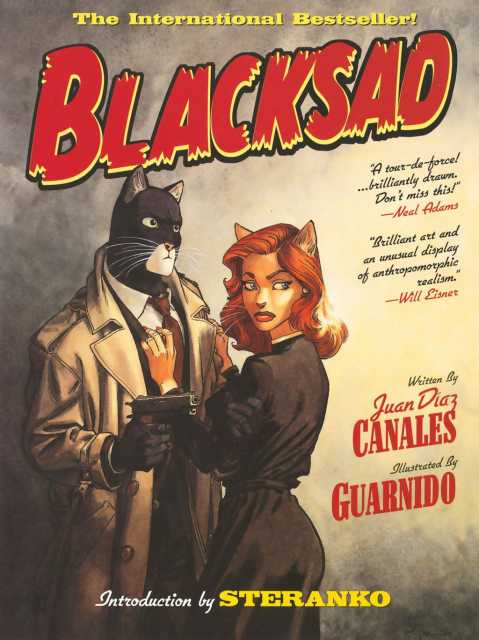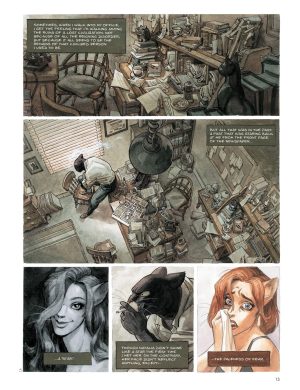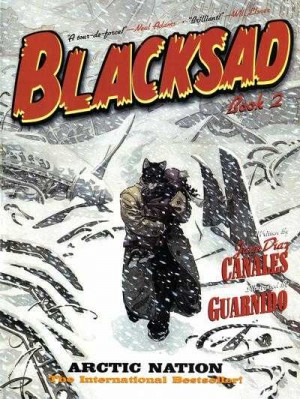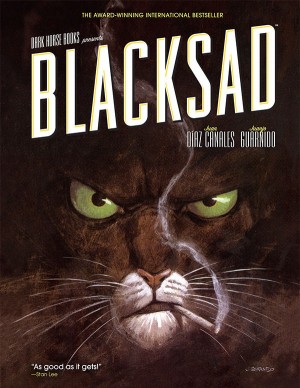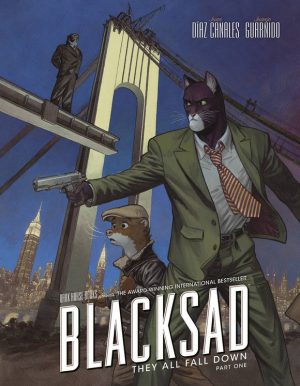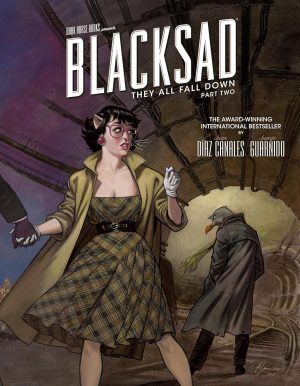Review by Frank Plowright
When first published in Europe, Blacksad was an instant sensation. Neither writer Juan Díaz Canales, nor artist Juanjo Guarnido were previously known to the comics world, yet their début was a stunning piece of work. That the Spanish creators were so accomplished first time out was due to their background in animation and a lifelong love of comics.
Blacksad‘s origins lie in another project the pair were compiling when Guarnido saw a short strip by Canales featuring a feline detective, and was very taken with it. He proposed “setting the animals free” within a realistic environment, and Blacksad was born.
He’s a panther, and a detective in a reality that’s beautifully realised by Guarnido, populated by animals that are familiar, yet walk upright and talk, inhabiting the USA of the late 1940s, so known in every other aspect. As Jim Steranko notes in his introduction, the cast are not animals who talk like people, but people who resemble animals. The cast conforms to human behavioural characteristics we apply to their animal counterparts. All species have evolved in this manner, although it’s rather fudged for additional sex appeal in the case of one cat woman. It makes for a succession of memorable images such as an apoplectic walrus talent agent, or an oran-utan singing the blues. Years of experience at Disney taught Guarnido how to humanise animals, and the emotional investment he generates is complete.
This would all be beautiful window dressing without Canales being equally accomplished. The testament to his skill is that were all the trappings removed Somewhere within the Shadows would remain a compelling detective mystery. An actress and former girlfriend of Blacksad’s is found murdered, and despite their relationship ending in acrimony he owes it to her to track down her killer. He’s almost immediately assaulted himself, and the case continues from there. Canales appropriates the noir crime novel and film tropes and works them all in to create a page-turning detective mystery.
An early creative decision was to present the story in colour for commercial reasons, rather than the black and white that might seem a more suitable fit for the material. Guarnido’s use of colour is stunning. It reflects mood, with the brightest and most colourful section being Blacksad’s recollection of the earliest days of his relationship with Natalia, and location, with varying shades of gloom the primary palette. Guarnido’s capacity for incidental detail is finely honed as well. Those populating the scenes react to the events, or are portrayed with their own concerns. A particularly fine example has Blacksad walking down a street of tenement blocks as in the foreground there’s a mini drama among a group of children.
There are problems with the translation, which weighs towards the literal rather than the idiomatic, and over the first third of the book this is occasionally intrusive.
The publication details here are for an out of print volume from a defunct publisher. The current English language printing is from Dark Horse, where this first volume is collected in slightly smaller format hardback with its two successors Arctic Nation and Red Soul, the latter never separately published in English. ibooks also issued a companion volume titled Blacksad: The Sketch Files, in which the creators discuss the project and their approach to work. It’s packed with page roughs and sketches, most annotated by Guarnido explaining his thought processes, and concluded with pin-ups from several European artists.
